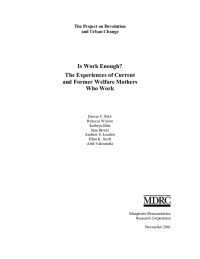Is Work Enough?
The Experiences of Current and Former Welfare Mothers Who Work
Since 1996, when Congress passed the Personal Responsibility and Work Opportunity Reconciliation Act · the "welfare reform" law · welfare caseloads have dropped sharply, and the number of single mothers who work has grown dramatically. But how have poor mothers fared, now that they are playing by the new welfare rules and working?
This report describes the experiences of women from poor urban neighborhoods who once relied on public assistance and entered the labor market. It presents findings from the Project on Devolution and Urban Change, a study of the implementation and effects of welfare reform in the counties encompassing four big cities: Cleveland, Los Angeles, Miami, and Philadelphia. This report draws on representative survey data and in-depth ethnographic interviews from each of those sites to compare the work experiences and life circumstances of four groups of women defined by employment status and history.
In May 1995, the 3,900 survey respondents were receiving public assistance and living in high-poverty neighborhoods. Three to four years later, they were interviewed about their recent employment experiences: Three-quarters had worked in the past two years, and about half were working at the time of the interview. Respondents' stories from the ethnographic interviews are interwoven throughout the report to complement and augment the survey findings.
Key Findings
- The majority of women who were working at the time of their interview had worked in most of the prior 24 months. Full-time employment was the norm, whether that employment was stable or not.
- Even among women who had been working most stably, the majority had low-wage jobs with earnings that put their families below the official poverty level.
- Among the employed women, about two out of five held jobs that provided no fringe benefits. Even among those who had worked most stably, only about half had jobs that offered health insurance.
- In most cases, the mothers' earnings were the primary source of household income. Most women and their families faced multiple material hardships, such as food insecurity, housing problems, and unmet health care needs.
- Nearly all the women who worked faced barriers or "challenges" to employment, such as their own or a child's health problems, less than high school education, or depression. The women who worked most stably faced fewer such obstacles.
- Public safety net programs (food stamps, Medicaid, housing assistance, child care subsidies) were not used by the majority of the women, despite their apparent eligibility for them.
Though the strong economic growth of the late 1990s would be expected to improve employment prospects generally, it is still noteworthy that so many current and former welfare recipients achieved high employment stability. Yet most were in jobs with low earnings and could not lift their families out of poverty without other sources of income. By documenting the pervasiveness of material hardship and poverty among women in this group (even among those working full time) and the fact that the public supports available to them often go unused, this study suggests that government policies aimed at addressing the needs of the working poor have fallen short of their goals.







